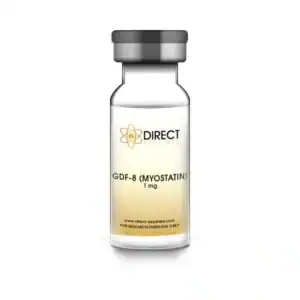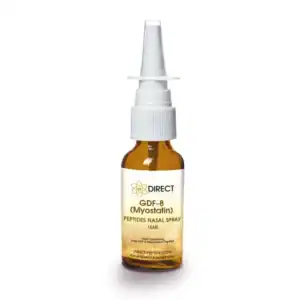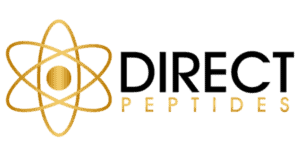Buy GDF-8 Myostatin Peptide
GDF-8, or Myostatin, is a growth differentiation factor that helps regulate muscle growth. Blocking Myostatin is often associated with increased muscle mass and may offer therapeutic benefits for conditions like muscle wasting and heart failure.
Shop our Full Range of GDF-8 Myostatin Peptides
-
Sale!

GDF-8 Pre-Mixed Pen 1mg
£93.79 – £253.23Price range: £93.79 through £253.23 This product has multiple variants. The options may be chosen on the product page -

GDF-8 Myostatin Peptide Vial
£88.19 – £97.17Price range: £88.19 through £97.17 This product has multiple variants. The options may be chosen on the product page -
Sale!

GDF-8 Myostatin Nasal Spray
£96.19 – £187.38Price range: £96.19 through £187.38 This product has multiple variants. The options may be chosen on the product page
What is GDF-8 Myostatin?
GDF-8, or Myostatin, is a growth factor protein involved in regulating muscle growth in the body. It belongs to the transforming growth factor-beta (TGF-β) superfamily and exists in a human latent form until it undergoes activation.
The mature GDF-8 protein is identical in its amino acid sequence across humans, mice, rats, and cows, highlighting its evolutionary conservation. Within the TGF-beta superfamily, GDF-8 is most closely related to BMP-11, a mammalian protein recognized for its role as a dorsal mesoderm and neural inducer in Xenopus explants.
This peptide functions by signalling the muscles to limit their size and growth, maintaining a precise balance. The amino acid composition of Myostatin and its recombinant forms are frequently studied to develop effective therapies. Blocking or modifying its activity has been associated with increased muscle mass, offering potential treatments for muscle wasting disorders, obesity, or enhancing recovery from muscle injuries. Researchers also utilise antibodies and membrane-bound receptors to study Myostatin’s role in muscle regulation, highlighting its therapeutic promise.
GDF-8 Myostatin Mechanism Of Action
GDF-8 Myostatin works by sending signals to muscle cells to slow down their growth. It acts like a brake, ensuring that muscles do not grow too large or out of control. This happens through a specific pathway where Myostatin binds to activin type II receptors (ActRIIB) on the surface of muscle cells, which triggers a chain reaction inside the cells to reduce muscle development.
By understanding this process, scientists can explore ways to block Myostatin’s signal, which could help boost muscle growth in people with muscle loss or weakness caused by illness or injury.
What Are The Research Benefits of GDF-8 Myostatin
Muscle Loss Treatment: Blocking Myostatin can promote muscle growth, offering a potential therapeutic option for conditions like muscular dystrophy or sarcopenia, where muscle wasting occurs [1].
Improved Tissue Regeneration: By inhibiting Myostatin, muscle tissue regeneration can be enhanced, which is critical for recovery in patients with muscle injuries or degenerative diseases [2].
Enhanced Strength and Performance: Research has demonstrated that animals genetically lacking Myostatin exhibit significantly increased muscle mass and strength, suggesting applications for enhancing physical capabilities in humans [3].
Treatment for Cachexia: Myostatin blockade has been shown to counteract muscle loss associated with cancer cachexia, improving patient quality of life and treatment outcomes [4].
Reduction of Age-Related Muscle Decline: Myostatin inhibitors may help mitigate age-related muscle loss and functional decline, aiding in improved mobility and independence in elderly populations [5].
Potential for Metabolic Improvement: Studies suggest that Myostatin suppression could enhance insulin sensitivity and metabolic health, with potential benefits for managing metabolic syndromes like diabetes [6].
Potential in Heart Failure Treatment: Emerging research indicates that Myostatin inhibition could play a role in the treatment of heart failure by promoting cardiomyocyte growth and function. Myostatin has been shown to negatively regulate cardiac muscle mass, and its suppression may enhance cardiac repair mechanisms, improving heart function and outcomes for patients with heart failure [7].
Applications in Veterinary Medicine: Myostatin inhibitors hold promise for improving muscle development in livestock such as Belgiun Blue cattle, which could enhance agricultural yields and efficiency within ethical guidelines [8] [9].
Buy GDF-8 Myostatin for research online today!
Buy GDF-8 Myostatin Peptide Vial
Buy GDF-8 Myostatin 1 mg. With 99% purity, this peptide is designed for advanced research and experiments. Supplied as a lyophilised powder for reconstitution, it’s ideal for studies on skeletal muscle growth, metabolism, and therapeutic innovation.
Buy Peptide Supplies for all your reconstitution needs, including premium Bacteriostatic Water and accessories.
Buy GDF-8 Myostatin Peptide Nasal Spray
 Buy GDF-8 Myostatin Nasal Spray, available in 15 ml and 30 ml sterile glass spray bottles. This formulation provides researchers with an easy and effective way to study GDF-8 Myostatin modulation.
Buy GDF-8 Myostatin Nasal Spray, available in 15 ml and 30 ml sterile glass spray bottles. This formulation provides researchers with an easy and effective way to study GDF-8 Myostatin modulation.
It ensures precise dosing, fast absorption, and targeted distribution, enabling advanced research in areas like muscle regeneration, metabolic health, and therapeutic development.
Frequently Asked Questions (FAQs) about GDF-8 Myostatin
What is the recommended storage for GDF-8 Myostatin peptide?
The peptide should be stored in a cool, dry location at -20°C in its lyophilised powder state. Once reconstituted, it is advised to refrigerate and use within the recommended time frame for optimal stability and efficacy.
Is this GDF-8 Myostatin peptide suitable for therapeutic use?
No, this product is strictly intended for research and experimental purposes. It is not suitable for human or animal therapeutic or diagnostic use.
How is GDF-8 Myostatin peptide administered in research?
The peptide is typically reconstituted with a suitable solvent before being used in experimental protocols. The method of administration varies based on the specific research design and objectives.
Why is purity important in GDF-8 Myostatin products?
High purity ensures the accuracy and reliability of experimental results. Impurities can cause inconsistent outcomes or interfere with the study’s objectives, making 99% purity an industry standard for research-grade peptides.
Is Myostatin illegal?
Myostatin itself is not illegal, but its use is heavily restricted in many countries. It is often regulated by authorities such as the United States Food and Drug Administration (FDA) and WADA (World Anti-Doping Agency) due to its potential misuse in performance enhancement or unapproved therapeutic applications [10]. Researchers must adhere to FDA regulations, local laws, and guidelines when working with Myostatin-related products to ensure compliance and ethical practices.
Do Myostatin inhibitors really work?
Myostatin inhibitors have shown promise in scientific studies and clinical trials, particularly in promoting muscle growth and improving muscle function. These inhibitors work by blocking the activity of Myostatin, a protein that limits muscle growth.
While early research demonstrates potential benefits, the effectiveness and safety of these inhibitors can vary depending on factors such as dosage, individual physiology, and the specific inhibitor being used. Further research is needed to fully understand their long-term impact and therapeutic applications.
Buy GDF-8 Myostatin Pre-Mixed Pen from Direct Peptides. Cartridges come with your chosen peptide pre-mixed with Bacteriostatic Water, plus pen needle tips. Kits include a pen, carry case, and extra tips. Save 10% when you buy 3 cartridges!
Summary of Research Applications
- Promotes muscle cell proliferation
- Reduces fat accumulation
- Improves physical strength and endurance
- Enhances cell regeneration and tissue repair
- Potential treatment for heart failure
- Promotes insulin sensitivity and metabolic health
GDF-8 Myostatin Peptide Quality Assured
At Direct Peptides , we provide 99% pure GDF-8 Myostatin peptides, made to strict quality standards for research use. When you choose to buy GDF-8 Myostatin peptides, you get products designed for safety, reliability, and precision.
Our peptides are designed to support research on muscle growth, cell regeneration, and metabolic regulation, providing reliable results for advanced studies.
References For Further Reading
[1] Alexandra C. McPherron, Ann M. Lawler and Se-Jin Lee (1997) Regulation of skeletal muscle mass in mice by a new TGF-p superfamily member – Nature volume 387, pages 83–90 (1997).
[2] Jinhong Zhu, Yong Li, Aiping Lu, Burhan Gharaibeh, Jianqun Ma (2011) Follistatin Improves Skeletal Muscle Healing after Injury and Disease through an Interaction with Muscle Regeneration, Angiogenesis, and Fibrosis – The American Journal Pathology, 2011 Aug, Volume 179 (Issue 2), Pages 915–930.
[3] Lisa-Anne Whittemore, Kening Song, Xiangping Li, Jane Aghajanian (2003) Inhibition of myostatin in adult mice increases skeletal muscle mass and strength – Biochemical & Biophysical Research Communication, 2003 Jan 24, Volume 300 (Issue 4), Pages965-71.
[4] Xiaolan Zhou, Jin Lin Wang, John Lu, Yanping Song, et al (2010) Reversal of Cancer Cachexia and Muscle Wasting by ActRIIB Antagonism Leads to Prolonged Survival – Cell, Volume 142, Issue 4, 20 August 2010, Pages 531-543.
[5] Michael R Morissette, Janelle C Stricker, Michael A Rosenberg, Cattleya Buranasombati, et al (2009) Effects of myostatin deletion in aging mice – Aging Cell, 2009 Sep, Volume 8 (Issue 5), Pages 573-83.
[6] Tingqing Guo,William Jou,Tatyana Chanturiya, Jennifer Portas, et al (2009) Myostatin Inhibition in Muscle, but Not Adipose Tissue, Decreases Fat Mass and Improves Insulin Sensitivity – PLoS One, 2009, Volume 4 (Issue 3), Page e4937.
[7] Sonakshi Sharma and Amol S. Patil (2024) Myostatin’s marvels: From muscle regulator to diverse implications in health and disease – Cell Biochemistry & Function, Volume42, Issue6, August 2024, Page e4106.
[8] D. Aiello, K. Patel, and E. Lasagna (2018) The myostatin gene: an overview of mechanisms of action and its relevance to livestock animals – Animal Genetics, Volume49, Issue6, December 2018, Pages 505-519.
[9] Rajeev Mishra, Rajesh Jha, Birendra Mishra, and Yong Soo Kim (2022) Maternal immunization against myostatin suppresses post-hatch chicken growth – PLoS One, 2022 Oct 6, Volume 17 (Issue 10), Page e0275753.
[10] Katja Walpurgis, Andreas Thomas, Wilhelm Schänzer, and Mario Thevis (2016) Myostatin inhibitors in sports drug testing: Detection of myostatin-neutralizing antibodies in plasma/serum by affinity purification and Western blotting – Proteomics Clinical Applications, 2016 Feb, Volume 10 (Issue 2), Pages 195-205.
[11] Yue Zhao, Guowen Liu, Frank C Zambito, Yan J Zhang, et al (2017) A multiplexed immunocapture liquid chromatography tandem mass spectrometry assay for the simultaneous measurement of myostatin and GDF-11 in rat serum using an automated sample preparation platform – Analytica Chimica Acta, 2017 Aug 1, Volume 979, Pages 36-44.
Why Choose Direct Peptides ?
Buy GDF-8 Myostatin from Direct Peptides for high-quality products you can trust. We offer a variety of options, including 1mg vials, nasal sprays (15ml and 30ml), and pre-mixed peptide pens. At Direct Peptides , we deliver the reliable products researchers need to support their projects with confidence.
ALL CONTENT AND PRODUCT INFORMATION AVAILABLE ON THIS WEBSITE IS FOR EDUCATIONAL PURPOSES ONLY.
DISCLAIMER: These products are intended solely as a research chemical only. This classification allows for their use only for research development and laboratory studies. The information available on our Direct Peptides website: https://direct-peptides.com is provided for educational purposes only. These products are not for human or animal use or consumption in any manner. Handling of these products should be limited to suitably qualified professionals. They are not to be classified as a drug, food, cosmetic, or medicinal product and must not be mislabelled or used as such.
Related Posts

What Is The Effect Of Myostatin Inhibition?
This blog explores the science behind myostatin inhibition, a promising area of research in muscle growth and fat loss. Myostatin, a protein that limits muscle development, can be blocked to enhance muscle growth, reduce fat, and prevent muscle degeneration. Compounds like ACE-031 and Follistatin 344 play a role in this process.

Unravelling GDF-8 Myostatin In Muscle Regeneration
This blog explores the transformative role of GDF-8 Myostatin in muscle growth regulation and its potential applications in medicine and fitness. GDF-8, or Myostatin, serves as a critical negative regulator of muscle development, ensuring balanced growth.

Unlock Muscle Growth With GDF-8 Myostatin
This blog explores GDF-8 Myostatin, a protein that regulates muscle growth and its potential to transform bodybuilding and health sciences. By inhibiting Myostatin, researchers have found benefits like increased muscle hypertrophy, strength, and recovery.
